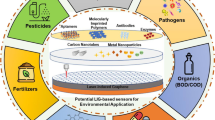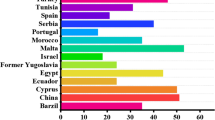Abstract
It is important to develop methods to determine microbial toxins at trace levels since these toxins are ubiquitous commonly found in water and foods, and pose potential threats to both human health and ecosystem safety. Taking the advantages of ultrahigh electron-transfer capability, extra-large surface area and easily functionalized ability, the graphene-based nanocomposites have been employed to fabricate electrochemical biosensors including immunosensors and aptasensors for detecting microbial toxins with high sensitivity. The specificity and selectivity of the electrochemical biosensors for targeting toxins can be achieved by combining graphene nanocomposites with antibodies and/or aptamers. The graphene nanocomposite-based electrochemical biosensors could become a promising technique in the detection of microbial toxins for public and environmental health protection.




Similar content being viewed by others
References
Ruchika C, Jay S, Tushar S, Basu T, Malhotra BD. Recent advances in mycotoxins detection. Biosens Bioelectron. 2016;81:532.
Monica C, Diana G, Beatriz PS. Novel nanobiotechnological concepts in electrochemical biosensors for the analysis of toxins. Analyst. 2012;137:1055.
Beutler B, Rietschel ET. Innate immune sensing and its roots: the story of endotoxin. Nat Rev Immunol. 2003;3:169.
Beatriz JS, Marta P, Jaime R, Alberto E. Magnetocatalytic graphene quantum Dots Janus micromotors for bacterial endotoxin detection. Angew Chem Int Ed. 2017;56:6957.
Sutarlie L, Ow SY, Su X. Nanomaterials-based biosensors for detection of microorganisms and microbial toxins. Biotechnol J. 2017;12:1500459.
Xu L, Zhang Z, Zhang Q, Li P. Mycotoxin determination in foods using advanced sensors based on antibodies or aptamers. Toxins. 2016;8:239.
Karapetis S, Nikoleli GP, Siontorou CG, Nikolelis DP, Tzamtzis N, Psaroudakis N. Development of an electrochemical biosensor for the rapid detection of cholera toxin based on air stable lipid films with incorporated ganglioside GM1 using graphene electrodes. Electroanalysis. 2016;28:1584.
Yang T, Huang H, Zhu F, Lin Q, Zhang L, Liu J. Recent progresses in nanobiosensing for food safety analysis. Sensors. 2016;16:118.
Yang W, Ratinac KR, Ringer SP, Thordarson P, Gooding JJ, Braet F. Carbon nanomaterials in biosensors: should you use nanotubes or graphene. Angew Chem Int Ed. 2010;49:2114.
Shao Y, Wang J, Wu H, Liu J, Aksay IA, Lin Y. Graphene based electrochemical sensors and biosensors: a review. Electroanalysis. 2010;22:1027.
Liu Y, Dong X, Chen P. Biological and chemical sensors based on graphene materials. Chem Soc Rev. 2012;41:2283.
Tiwari JN, Vij V, Kemp KC, Kim KS. Engineered carbon-nanomaterial-based electrochemical sensors for biomolecules. ACS Nano. 2015;10:46.
Bahadır EB, Sezgintürk MK. Applications of graphene in electrochemical sensing and biosensing. TrAC Trends Anal Chem. 2016;76:1.
Thévenot DR, Toth K, Durst RA, Wilson GS. Electrochemical biosensors: recommended definitions and classification. Biosens Bioelectron. 2001;16:121.
Radi AE, Muñoz-Berbel X, Cortina-Puig M, Marty JL. An electrochemical immunosensor for ochratoxin A based on immobilization of antibodies on diazonium-functionalized gold electrode. Electrochim Acta. 2009;54:2180.
Tong P, Zhang L, Xu JJ, Chen HY. Simply amplified electrochemical aptasensor of ochratoxin A based on exonuclease-catalyzed target recycling. Biosens Bioelectron. 2011;29:97.
Chiriacò MS, Primiceri E, D’amone E, Lonescu RE, Rinaldi R, Maruccio G. EIS microfluidic chips for flow immunoassay and ultrasensitive cholera toxin detection. Lab Chip. 2011;11:658.
Wang D, Hu W, Xiong Y, Xu Y, Li CM. Multifunctionalized reduced graphene oxide-doped polypyrrole/pyrrolepropylic acid nanocomposite impedimetric immunosensor to ultra-sensitively detect small molecular aflatoxin B1. Biosens Bioelectron. 2015;63:185.
Loo AH, Bonanni A, Pumera M. Mycotoxin aptasensing amplification by using inherently electroactive graphene-oxide nanoplatelet labels. ChemElectroChem. 2015;2:743.
Hao N, Jiang L, Qian J, Wang K. Ultrasensitive electrochemical ochratoxin A aptasensor based on CdTe quantum dots functionalized graphene/Au nanocomposites and magnetic separation. J Electroanal Chem. 2016;781:332.
Sun AL, Zhang YF, Sun GP, Wang XN, Tang D. Homogeneous electrochemical detection of ochratoxin A in food stuff using aptamer-graphene oxide nanosheets and DNase I-based target recycling reaction. Biosens Bioelectron. 2017;89:659.
Shi ZY, Zheng YT, Zhang HB, He CH, Wu WD, Zhang HB. DNA electrochemical aptasensor for detecting fumonisins B1 based on graphene and thionine nanocomposite. Electroanalysis. 2015;27:1097.
Fang YS, Chen SY, Huang XJ, Wang LS, Wang HY, Wang JF. Simple approach for ultrasensitive electrochemical immunoassay of Clostridium difficile toxin B detection. Biosens Bioelectron. 2014;53:238.
Zhu K, Dietrich R, Didier A, Doyscher D, Märtlbauer E. Recent developments in antibody-based assays for the detection of bacterial toxins. Toxins. 2014;6:1325.
Afkhami A, Hashemi P, Bagheri H, Salimian J, Ahmadi A, Madrakian T. Impedimetric immunosensor for the label-free and direct detection of botulinum neurotoxin serotype A using Au nanoparticles/graphene–chitosan composite. Biosens Bioelectron. 2017;93:124.
Sharma A, Rao VK, Kamboj DV, Gaur R, Shaik M, Shrivastava AR. Enzyme free detection of staphylococcal enterotoxin B (SEB) using ferrocene carboxylic acid labeled monoclonal antibodies: an electrochemical approach. New J Chem. 2016;40:8334.
Lu L, Seenivasan R, Wang YC, Yu JH, Sundaram G. An Electrochemical immunosensor for rapid and sensitive detection of mycotoxins fumonisin B1 and deoxynivalenol. Electrochim Acta. 2016;213:89.
Tang J, Huang Y, Zhang C, Liu H, Tang D. Amplified impedimetric immunosensor based on instant catalyst for sensitive determination of ochratoxin A. Biosens Bioelectron. 2016;86:386.
Bruno JG, Kiel JL. Research report use of magnetic beads in selection and detection of biotoxin aptamers by electrochemilumines-cence and enzymatic methods. Biotechniques. 2002;32:178.
Cruz-Aguado JA, Penner G. Fluorescence polarization based displacement assay for the determination of small molecules with aptamers. Anal Chem. 2008;80:8853.
Cruz-Aguado JA, Penner G. Determination of ochratoxin A with a DNA aptamer. J Agric Food Chem. 2008;56:10456.
Amaya-González S, de-los-Santos-Álvarez N, Miranda-Ordieres AJ, Lobo-Castañón MS. Aptamer-based analysis: a promising alternative for food safety control. Sensors. 2013;13:16292.
Labib M, Berezovski MV. Electrochemical aptasensors for microbial and viral pathogens. Biosens Based Aptamers Enzym Spring: Berlin Heidelberg; 2013. p. 155–81.
Huang Y, Chen X, Xia Y, Wu S, Duan N, Ma X, Wang Z. Selection, identification and application of a DNA aptamer against Staphylococcus aureus enterotoxin A. Anal Methods. 2014;6:690.
Bai L, Chai Y, Pu X, Yuan R. A signal-on electrochemical aptasensor for ultrasensitive detection of endotoxin using threeway DNA junction-aided enzymatic recycling and graphene nanohybrid for amplification. Nanoscale. 2014;6:2902.
Liu M, Yu J, Ding X, Zhao G. Photoelectrochemical aptasensor for the sensitive detection of microcystin-LR Based on graphene functionalized vertically-aligned TiO2 nanotubes. Electroanalysis. 2016;28:161.
Author information
Authors and Affiliations
Corresponding author
About this article
Cite this article
Geleta, G.S., Zhao, Z. & Wang, Z. Electrochemical Biosensors for Detecting Microbial Toxins by Graphene-Based Nanocomposites. J. Anal. Test. 2, 20–25 (2018). https://doi.org/10.1007/s41664-018-0051-y
Received:
Accepted:
Published:
Issue Date:
DOI: https://doi.org/10.1007/s41664-018-0051-y




